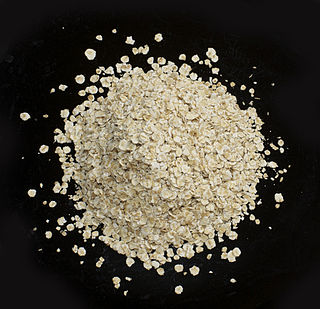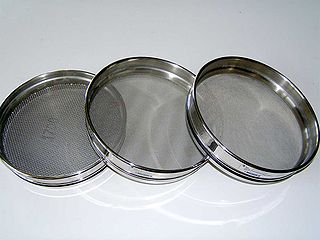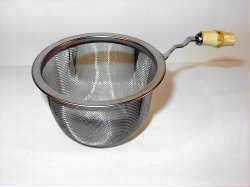
A wok is a deep round-bottomed cooking pan from China. It is believed to be derived from the South Asian karahi. It is common in that country, and similar pans are found in parts of East, South and Southeast Asia, as well as being popular in other parts of the world.

A spoon is a utensil consisting of a shallow bowl, oval or round, at the end of a handle. A type of cutlery, especially as part of a place setting, it is used primarily for transferring food to the mouth. Spoons are also used in food preparation to measure, mix, stir and toss ingredients and for serving food. Present day spoons are made from metal, wood, porcelain or plastic. There are a wide variety of spoons that are made of a variety of materials and by different cultures for many different uses and foods.

Teppanyaki, often confused with hibachi, is a post-World War II style of Japanese cuisine that uses an iron griddle to cook food. The word teppanyaki is derived from teppan, the metal plate on which it is cooked, and yaki, which means grilled, broiled, or pan-fried. In Japan, teppanyaki refers to dishes cooked using a teppan, including steak, shrimp, okonomiyaki, yakisoba and monjayaki.

Oatmeal is a preparation of oats that have been de-husked, steamed, and flattened, or a coarse flour of hulled oat grains (groats) that have either been milled (ground), rolled, or steel-cut. Ground oats are also called white oats. Steel-cut oats are known as coarse oatmeal, Irish oatmeal, or pinhead oats. Rolled oats were traditionally thick old-fashioned oats, but can be made thinner or smaller, and may be categorized as quick oatmeal or instant oatmeal depending on the cooking time required, which is determined by the size of the oats and the amount of precooking.

A French press, also known as a cafetière, cafetière à piston, caffettiera a stantuffo, press pot, coffee press, or coffee plunger, is a coffee brewing device, although it can also be used for other tasks. The earliest known device was patented in 1852 in France by Jacques-Victor Delforge and Henri-Otto Mayer.

A mortar and pestle is a set of two simple tools used to prepare ingredients or substances by crushing and grinding them into a fine paste or powder in the kitchen, laboratory, and pharmacy. The mortar is characteristically a bowl, typically made of hard wood, metal, ceramic, or hard stone such as granite. The pestle is a blunt, club-shaped object. The substance to be ground, which may be wet or dry, is placed in the mortar where the pestle is pounded, pressed, or rotated into the substance until the desired texture is achieved.

A sieve, fine mesh strainer, or sift, is a device for separating wanted elements from unwanted material or for controlling the particle size distribution of a sample, using a screen such as a woven mesh or net or perforated sheet material. The word sift derives from sieve.

Ami jakushi (網杓子) is a skimmer used in the Japanese kitchen. The skimmer is made from a fine wire mesh and is used to remove small pieces of unwanted food or foam from a liquid. For example, in deep frying, the ami jakushi is used to remove small drops of batter during the frying of tempura. Another example would be the removal of foam from a miso soup to achieve a more pleasing aesthetic.

A mesh is a barrier made of connected strands of metal, fiber, or other flexible or ductile materials. A mesh is similar to a web or a net in that it has many attached or woven strands.

A tava(h) / tawa(h) (mainly on the Indian subcontinent), saj (in Arabic), sac (in Turkish), and other variations and combinations thereof, is a metal-made cooking utensil. The tawa is round and can be flat, but more commonly has a curved profile, and while the concave side can be used as a wok or frying pan, the convex side is used for cooking flatbreads and pancakes.

A chinois is a conical sieve with an extremely fine mesh. It is used to strain custards, purees, soups, and sauces, producing a very smooth texture. It can also be used to dust food with a fine layer of powdered ingredient.

Ricing is a cooking term meaning to pass food through a food mill or "ricer", which comes in several forms. In the most basic, food is pushed or pressured through a metal or plastic plate with many small holes, producing a smoother result than mashing, but coarser than pureeing or passing through a sieve or tamis. The size of the product produced by ricing is about the same as grains of rice.

Bisque is a smooth, creamy, highly seasoned soup of French origin, classically based on a strained broth (coulis) of crustaceans. It can be made from lobster, langoustine, crab, shrimp or crayfish. The French bisque is one of the most popular seafood soups around the world.

A window screen is designed to cover the opening of a window. It is usually a mesh made of metal, fibreglass, plastic wire, or other pieces of plastic and stretched in a frame of wood or metal. It serves to keep leaves, debris, bugs, birds, and other animals from entering a building or a screened structure such as a porch, without blocking fresh air-flow.

A food mill is a food preparation utensil for mashing and sieving soft foods invented in Brussels in 1928 by Victor Simon. Typically, a food mill consists of three parts: a bowl, a bottom plate with holes like those in a colander, and a crank fitted with a bent metal blade that crushes the food and forces it through the holes in the plate. The bottom plate may be a permanent part of the device, or interchangeable plates with different hole sizes may be supplied. Three corrugated feet on the base, or two ears on the rim plus the handle, fit on the rim of a cooking pot and hold the mill in position over it.

A kitchen scraper is a kitchen implement made of metal, plastics, wood, rubber or silicone rubber. In practice, one type of scraper is often interchanged with another or with a spatula for some of the various uses.

A kitchen utensil is a small hand held tool used for food preparation. Common kitchen tasks include cutting food items to size, heating food on an open fire or on a stove, baking, grinding, mixing, blending, and measuring; different utensils are made for each task. A general purpose utensil such as a chef's knife may be used for a variety of foods; other kitchen utensils are highly specialized and may be used only in connection with preparation of a particular type of food, such as an egg separator or an apple corer. Some specialized utensils are used when an operation is to be repeated many times, or when the cook has limited dexterity or mobility. The number of utensils in a household kitchen varies with time and the style of cooking.

Chopsticks are shaped pairs of equal-length sticks that have been used as kitchen and eating utensils in most of East and Southeast Asia for over three millennia. They are held in the dominant hand, secured by fingers, and wielded as extensions of the hand, to pick up food.

Seasoning or curing is the process of coating the surface of cookware with a bioplastic formed from heated fat or oil in order to produce a heat, corrosion, and stick resistant hard coating. It is required for cast-iron cookware and carbon steel, which otherwise rust rapidly in use, but is also used for many other types of cookware, as it helps prevent food sticking.
Rubber pollution, similar to plastic pollution, occurs in various environments, and originates from a variety of sources, ranging from the food industry processing chain to tire wear. Synthetic and natural rubber dust and fragments now occur in food, airborne as particulates in air pollution, hidden in the earth as soil pollution, and in waterways, lakes and the sea.




















